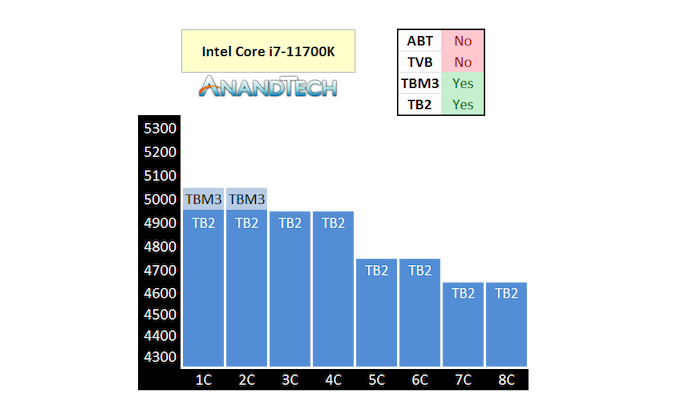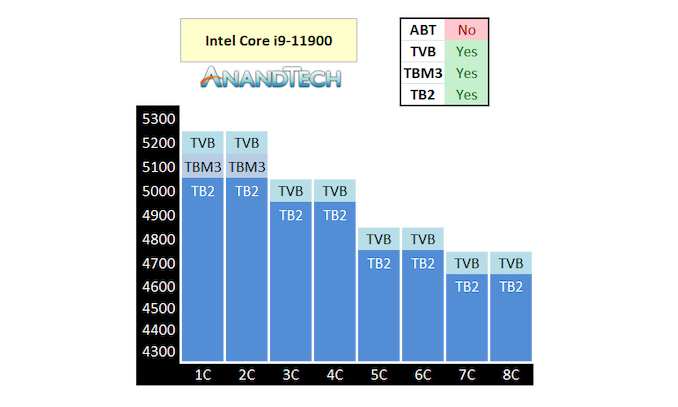Intel Rocket Lake (14nm) Review: Core i9-11900K, Core i7-11700K, and Core i5-11600K
by Dr. Ian Cutress on March 30, 2021 10:03 AM EST- Posted in
- CPUs
- Intel
- LGA1200
- 11th Gen
- Rocket Lake
- Z590
- B560
- Core i9-11900K
Intel’s New Adaptive Boost Technology for Core i9-K/KF
Taken from our news item
To say that Intel’s turbo levels are complicated to understand is somewhat of an understatement. Trying to teach the difference between the turbo levels to those new to measuring processor performance is an art form in of itself. But here’s our handy guide, taken from our article on the subject.
Adaptive Boost Technology is now the fifth frequency metric Intel uses on its high-end enthusiast grade processors, and another element in Intel’s ever complex ‘Turbo’ family of features. Here’s the list, in case we forget one:
| Intel Frequency Levels | ||
| Base Frequency | - | The frequency at which the processor is guaranteed to run under warranty conditions with a power consumption no higher than the TDP rating of the processor. |
| Turbo Boost 2.0 | TB2 | When in a turbo mode, this is the defined frequency the cores will run at. TB2 varies with how many cores are being used. |
| Turbo Boost Max 3.0 | TBM3 'Favored Core' |
When in a turbo mode, for the best cores on the processor (usually one or two), these will get extra frequency when they are the only cores in use. |
| Thermally Velocity Boost | TVB | When in a turbo mode, if the peak thermal temperature detected on the processor is below a given value (70ºC on desktops), then the whole processor will get a frequency boost of +100 MHz. This follows the TB2 frequency tables depending on core loading. |
| Adaptive Boost Technology | ABT 'floating turbo' |
When in a turbo mode, if 3 or more cores are active, the processor will attempt to provide the best frequency within the power budget, regardless of the TB2 frequency table. The limit of this frequency is given by TB2 in 2-core mode. ABT overrides TVB when 3 or more cores are active. |
| *Turbo mode is limited by the turbo power level (PL2) and timing (Tau) of the system. Intel offers recommended guidelines for this, but those guidelines can be overridden (and are routinely ignored) by motherboard manufacturers. Most gaming motherboards will implement an effective ‘infinite’ turbo mode. In this mode, the peak power observed will be the PL2 value. It is worth noting that the 70ºC requirement for TVB is also often ignored, and TVB will be applied whatever the temperature. | ||
Intel provided a slide trying to describe the new ABT, however the diagram is a bit of a mess and doesn’t explain it that well. Here’s the handy AnandTech version.
First up is the Core i7-11700K that AnandTech has already reviewed. This processor has TB2, TBM3, but not TVB or ABT.
The official specifications show that when one to four cores are loaded, when in turbo mode, it will boost to 4.9 GHz. If it is under two cores, the OS will shift the threads onto the favored cores and Turbo Boost Max 3.0 will kick in for 5.0 GHz. More than four core loading will be distributed as above.
On the Core i9-11900, the non-overclocking version, we also get Thermal Velocity Boost which adds another +100 MHz onto every core max turbo, but only if the processor is below 70ºC.
We can see here that the first two cores get both TBM3 (favored core) as well as TVB, which makes those two cores give a bigger jump. In this case, if all eight cores are loaded, the turbo is 4.6 GHz, unless the CPU is under 70ºC, then we get an all-core turbo of 4.7 GHz.
Now move up to the Core i9-11900K or Core i9-11900KF, which are the only two processors with the new floating turbo / Adaptive Boost Technology. Everything beyond two cores changes and TVB no longer applies.
Here we see what looks like a 5.1 GHz all-core turbo, from three cores to eight cores loaded. This is +300 MHz above TVB when all eight cores are loaded. But the reason why I’m calling this a floating turbo is because it is opportunistic.
What this means is that, if all 8 cores are loaded, TB2 means that it will run at 4.7 GHz. If there is power budget and thermal budget, it will attempt 4.8 GHz. If there is more power budget and thermal budget available, it will go to 4.9 GHz, then 5.0 GHz, then 5.1 GHz. The frequency will float as long as it has enough of those budgets to play with, and it will increase/decrease as necessary. This is important as different instructions cause different amounts of power draw and such.
If this sounds familiar, you are not wrong. AMD does the same thing, and they call it Precision Boost 2, and it was introduced in April 2018 with Zen+. AMD applies its floating turbo to all of its processors – Intel is currently limiting floating turbo to only the Core i9-K and Core i9-KF in Core 11th Gen Rocket Lake.
One of the things that we noticed with AMD however is that this floating turbo does increase power draw, especially with AVX/AVX2 workloads. Intel is likely going to see similar increases in power draw. What might be a small saving grace here is that Intel’s frequency jumps are still limited to full 100 MHz steps, whereas AMD can do it on the 25 MHz boundary. This means that Intel has to manage larger steps, and will likely only cross that boundary if it knows it can be maintained for a fixed amount of time. It will be interesting to see if Intel gives the user the ability to change those entry/exit points for Adaptive Boost Technology.
There will be some users who are already familiar with Multi-Core Enhancement / Multi-Core Turbo. This is a feature from some motherboard vendors have, and often enable at default, which lets a processor reach an all-core turbo equal to the single core turbo. That is somewhat similar to ABT, but that was more of a fixed frequency, whereas ABT is a floating turbo design. That being said, some motherboard vendors might still have Multi-Core Enhancement as part of their design anyway, bypassing ABT.
Overall, it’s a performance plus. It makes sense for the users that can also manage the thermals. AMD caught a wind with the feature when it moved to TSMC’s 7nm. I have a feeling that Intel will have to shift to a new manufacturing node to get the best out of ABT, and then we might see the feature on the more mainstream CPUs, as well as becoming default as standard.













279 Comments
View All Comments
Beaver M. - Wednesday, March 31, 2021 - link
Acting like GN and HUB gives them lots of AMD fanboy clicks/views.Beaver M. - Wednesday, March 31, 2021 - link
I guess living in isolation for a year makes people more and more antisocial and aggressive. And that then in turn sells well.Qasar - Wednesday, March 31, 2021 - link
so they are amd fanboys cause they told the truth ? more like you are the intel fanboy trying to defend this dud of a cpu. come on, most reviews say they same thing, just some are more harsh, and rightfully soOxford Guy - Wednesday, March 31, 2021 - link
Tech fans are continually disappointed by the lack of adequate competition in a multitude of tech markets (e.g. GPUs, CPUs, search, leading-edge lithography machines/foundries, etc. etc.)We saw, way back in the 80s, what happens when competition is shut down. The Japanese seized the DRAM market by dumping, forcing American DRAM makers out of the market — then promptly raising prices drastically.
We went from seeing revolutionary products like the Apple Lisa being replaced by years of toy-grade machines at very high prices. The Lisa shipped with 1 MB of RAM and the first Mac with just 128K. The Apple IIGS shipped with just 256K, many years after the Lisa. We can thank more than Apple's love of fat margins. We can thank inadequate competition.
We have seen that play out, time and time again. Now, it's so bad that it's worse than the bread lines of the USSR. At least if one waited in one of those one might end up with some bread. These days, you have two choices: a line to get a very overpriced product (like the latest iPhone) or you can skip waiting in line because they're nothing to buy (GPUs).
Oxford Guy - Wednesday, March 31, 2021 - link
(The Amiga 1000 only shipped with 256K of RAM, too, as I recall. It was a problem throughout the industry, not something due merely to Apple's margins.)GeoffreyA - Saturday, April 3, 2021 - link
I agree with your anti-corporation sentiment, but there's little we can do, except sigh. A worldwide boycotting of their products will work wonders but that'll never happen. As long as these rotters are out to make money---Intel, AMD, Google, the rest---it'll go on like this. Who knows, perhaps there's some vital link to entropy in all this, and why everything always goes awry on earth.Oxford Guy - Wednesday, March 31, 2021 - link
'One of the few tech sites that remained professional and didn't use click baity titles or disrespect intel.'This article uses bad spin to try to make Intel's product look better than it is.
Just one example:
‘Intel has stated that in the future it will have cores designed for multiple process nodes at the same time, and so given Rocket Lake’s efficiency at the high frequencies, doesn’t this mean the experiment has failed? I say no, because it teaches Intel a lot in how it designs its silicon’
The spin also includes the testing, using a really loud high-CFM CPU cooler in the Intel and a different quieter one on the AMD.
It's a pile of spin, like the glorified press release stuff trying to turn CEO Pat into some sort of superhero. That stuff sounds like it was written for investors.
FirstStrike - Wednesday, March 31, 2021 - link
Ian, you are missing SpecInt and SpectFp suiteOrkiton - Wednesday, March 31, 2021 - link
I'm not either Intel or AMD "fanboy" though some sympathy to AMD due to unfair, anti-competitive Intel practices in the past and AMD merit to emerge from their ashes. That said, best wishes to both in the name of progress, innovation and better value to us, the consumers.Oxford Guy - Wednesday, March 31, 2021 - link
The rated TDP is 125 W, although we saw 160 W during a regular load, 225 W peaks with an AVX2 rendering load, and 292 W peak power with an AVX-512 compute load.‘Intel’s claimed TDP’ rather than ‘that rated’. The latter implies an independent rating standard/body.
If both processors were found at these prices, then the comparison is a good one – the Ryzen 7 5800X in our testing scored +8% in CPU tests and +1% in gaming tests (1080p Max). The Ryzen is very much the more power-efficient processor, however the Intel has integrated graphics (an argument that disappears with KF at $374).
Again, no specifics about the power consumption difference.
On high-end gaming both processor performed the same, the AMD processor was ahead an average of 8% on CPU workloads, and the AMD processor came across as a lot more efficient and easy to cool, while the Intel processor scored a big lead in AVX-512 workloads.
Again, no specifics about the power consumption difference.
AGAIN, testing AMD with a weaker cooler, even though the CPU will go faster with the loud fast cooling you’re using on Intel.
Makes it APPLES to APPLES.